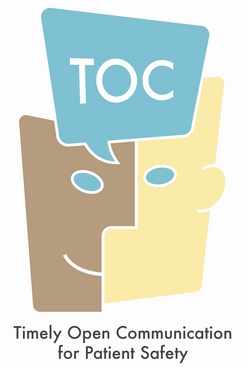



Timely Open Communication for Patient Safety

Communication is an essential element in patient safety.
Building on the success of previous inter-professional projects at Queen’s, The Timely Open Communication for Patient Safety (TOC) project will facilitate patient safety through improved inter-professional communication to help reduce the number and magnitude of patient safety incidents, or adverse events, at two critical times: admission to an institution and at discharge. [2]
Adverse events (AE) are "unintended injuries or complications resulting in death, disability or prolonged hospital stay that arise from health care management."[4]
Canadian data suggests that in 2000, 1 or more adverse events occurred in 7.5% of acute care hospital admissions, this represents approximately 185 000 admissions. 70 000 of these AEs are potentially preventable.[4]
The Canadian Patient Safety Institute (CPSI) has identified 6 domains of patient safety:
Contribute to a culture of patient safety - apply core patient safety knowledge, skills and attitudes to everyday work
Work in teams for patient safety
Communicate effectively for patient safety
Manage safety risks - anticipate, recognize and manage situations that place patients at risk
Optimize human and environmental factors
Recognize, respond to and disclose adverse events - mitigate harm to patients by ensuring disclosure and preventing recurrence of adverse events and close calls [5]
Communication is an essential element in patient safety around the world and for international bodies such as the World Health Organization.[3]
Breakdown in communication was the leading root cause of sentinel events reported to the Joint Commission in the United States of America between 1995 and 2006.
Of the 25 000 to 30 000 preventable adverse events that led to permanent disability in Australia, 11% were due to communication issues, in contrast to 6% due to inadequate skill levels of practitioners. [1]
Is it possible that issues of patient safety may be more related to how we work together than our technical skill or ability to do our work?
This module is about communication - communicating to make the care we provide safer for patients and more meaningful for us as providers. Communication that is open and timely. This is about working smarter. This is about improving patient safety.
Like every subject, there are specific terms or ways that words are used when discussing patient safety. Before we begin, test your knowledge of patient safety terms:[6][7]

Objectives
After completing this module you will be able to:
Describe the skills to communicate more effectively with your interprofessional team
Outline the skills to communicate better with patients and families
Describe how improved communication will lead to more complete and comprehensive care
List factors that can make communication with other institutions and community care providers difficult
Describe key issues in patient safety for care givers and family members
By attending to communication and patient safety throughout the admission and discharge process we expect to see a reduction in the number and magnitude of adverse events. We hope that you will feel more satisfied with the care you and your team provide to patients and families
Before answering the questions below ensure that you have registered to record your answers in a personal portfolio by entering your email address in the sidebar on your left.
Your experience of communication in health care
_________________________________
1. World Health Organization. Communication During Patient Hand-overs. Patient Safety Solutions. 2007;May. Available from: www.ccforpatientsafety.org/Patient-Safety-Solutions/
2. Timely Open Communication for Patient Safety Project. Queen's University Office of Interprofessional Education and Practice. Available from: meds.queensu.ca/oipep/research_projects/toc
3. The World Health Organization - Patient Safety. Available from: www.who.int/patientsafety/en/
4. Baker GR, Norton PG, Flintoft, et al. The Canadian Adverse Events Study: the incidence of adverse events among hospital patients in Canada. CMAJ 2004;170(11):678-86.
5. Patient Safety Competencies Framework. Canadian Patient Safety Institute. cited December 7, 2009. Available from: www.patientsafetyinstitute.ca/English/education/safetyCompetencies/Pages/KeyMessages.aspx
6. Best Practices in Patient Safety Education - Module handbook.University of Washington Centre for Health Sciences Interprofessional Education. Seattle Washington. May 2004.
7. Frank JR, Brien S (Editors)on behalf of he Safety Competencies Steering Committee. The Patient Safety Competencies: Enhancing Patient Safety Across the Health Professions. Ottawa, ON. Canadian Patient Safety Institute; 2008.
